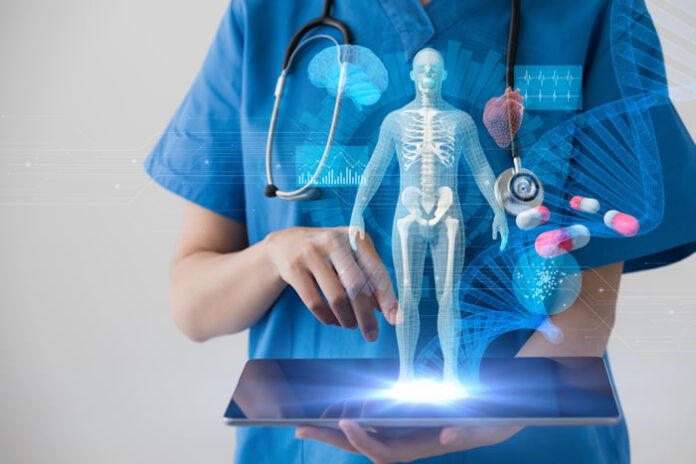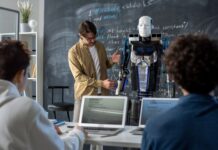Artificial intelligence and machine learning have permeated many aspects of modern life, from entertainment to supply chain logistics, financial services, retail, and beyond. The healthcare industry is no exception. Spending on artificial intelligence in healthcare is projected to increase at a rate of 48% annually through 2023. This surge in spending makes sense, given the widespread digitization of healthcare-related data and information.
What is not so clear in discussions about the future of healthcare is the difference between artificial intelligence (AI) and machine learning (ML) and their specific roles in the industry. Very often, AI and ML are lumped together as being one and the same. In reality, however, there is utility in understanding them as different aspects of an overall information ecosystem involving analysis, prediction, and action.
Artificial Intelligence Defined
The starting point for understanding AI is our own intelligence. Humans have the capacity to learn, to solve problems, to recognize patterns, and to explain and predict natural phenomena– all attributes commonly associated with intelligence. Perhaps most importantly, we’re able to act in ways that shape and transform our environment for our benefit.
AI, understood most generally, refers to a system or group of systems that is able to simulate that kind of human intelligence. An intelligent system would be one that exhibits human-like capacities for reasoning, problem-solving, or even creativity. The ultimate goal for many researchers is to generate an artificial general intelligence (AGI), something analysts acknowledge has not yet been achieved.
As technology currently stands, a particular AI might be good at simulating one aspect of human intelligence, but not others. There are AI systems, for example, that are proficient at understanding language, while others are good at fine motor control. There are very few that can do both.
Examples of AI in Healthcare
Narrow AI systems have been deployed in the healthcare industry for many years. In most cases, AI serves as an important aid for human-centric decision-making or action.
Natural Language Processing and Healthcare Documentation
The healthcare industry, writ large, generates huge amounts of documentation: patient records, clinical data, medical device documentation, pharmaceutical development records, hospital administration documentation, and more.
Natural language processing (NLP), a goal of AI since the field’s inception, focuses on speech recognition, textual analysis, and overall capacities for understanding language, whether written or spoken. NLP systems are used in healthcare to classify, interpret, transcribe, and otherwise manage large amounts of clinical records and research. The goal is to aid healthcare decision-making by automating management and integration of large amounts of digitized documentation.
Robotic Surgery
Another application of AI in the healthcare industry is robotic surgery. Surgical robots are gradually becoming more common in the OR, primarily as assistants to human surgeons. Robots can be programmed to exhibit fine-grained control of movement. They are not subject to muscle fatigue. These characteristics can be of great benefit to medical practitioners during long, complex surgical procedures that require a great deal of precision.
Machine Learning Defined
ML is best conceived as a specific kind of AI. ML is fundamentally about a machine’s ability to recognize fine-grained patterns in large data sets, patterns that are often inaccessible to human cognition. The kinds of patterns that ML techniques can recognize are diverse and may emerge from visual signals, linguistic signals, or any other kind of data.
A fundamental aspect of ML is that machines must be trained for pattern recognition. ML is the process of a particular machine iteratively refining itself on many data sets and adjusting performance outcomes based on feedback from human programmers.
Suppose, for instance, that you are developing a speech recognition machine. You set the machine up with an algorithm that delivers a particular output (speech recognition) when given a particular input (a fragment of human speech). The probability that the machine delivers a satisfactory output at first is very low. However, with high-throughput iterative fine-tuning of the algorithm, programmers can train a machine to recognize speech. The machine has “learned” to recognize speech fragments that it has never heard before.
Examples of Machine Learning in Healthcare
ML algorithms are widely used across industries and constitute one of the primary computational methods underlying advanced AI systems. ML is currently being used in a wide variety of ways in the healthcare sector.
Medical Imaging and Disease Detection
Perhaps the best use case of ML in healthcare is diagnostics based on medical imaging. The development of ML has been strongly associated with image processing, so ML algorithms excel at finding subtle patterns in medical imaging scans that might go unnoticed by professionals. For example, ML has been developed for early detection of lung cancer, improving the prognosis of many afflicted patients.
Medical Data Management
Many healthcare costs are directly related to administrative tasks associated with managing large amounts of patient-related data. ML algorithms can be used to automate tasks, like following up on unpaid bills, ensuring quality assurance in record keeping, pre-authorizing insurance, pre-ordering supplies, and many other activities.
Automating machines to do this kind of work frees up healthcare personnel to focus more squarely on patient care and also saves hospitals and clinics time and money.
The two applications described here really are the tip of the iceberg. Within the healthcare industry, ML is currently being used in a wide variety of applications, including records management, medical imaging, diagnostics, drug development, medical data, and disease detection.
The Difference Between AI and Machine Learning
AI and ML are parts of an informational ecosystem, but how should we understand the relationship between them? And what role do each play in healthcare practice and business decision-making?
AI is a general category, including any machine that reliably simulates some aspect of human intelligence. Accordingly, AI is best understood as a capacity, or set of capacities, that is similar to intelligent human cognition and behavior. ML is one of several processes that underlies those capacities. ML implements human-influenced algorithms that ultimately enable machines to analyze extremely large data sets and generate novel conclusions about patterns within those data sets. Just what to do with those conclusions is something that goes beyond ML by itself.
In principle, AI could use the outputs of specific ML systems to generate broad conclusions, make decisions, and perform actions on the basis of those decisions. Given the current state of technology, however, no AI exists that can do those things reliably. Accordingly, most of the hypotheses, conclusions, and behaviors that guide healthcare policy and business decisions are made by human beings, albeit with the aid of AI and ML.
Pattern recognition in extremely large data sets is a kind of intelligence that ML is very good at that goes beyond human cognitive capacities. So, specialized ML tools can deliver data that greatly aids humans in their ability to serve patients, whether it is through diagnosis, data
management, or some other application. As healthcare-related technology grows more sophisticated and more autonomous (as it has with deep learning, for example), it often becomes less clear just how AI and ML are reaching their conclusions, sidelining human cognition even further.
For now, however, human healthcare practitioners and executives are in the driver’s seat when it comes to healthcare decisions that affect patients and business. Specific ML algorithms make large amounts of data manageable and coherent, and more general AI systems serve as prosthetic enhancements for human behavior and decision-making capacities.
How to Keep the Pace
There is little doubt that AI-based technologies will deeply affect the future of healthcare in ways that have yet to be appreciated. AI and ML will continue to see massive growth within the healthcare sector. To stay current, healthcare businesses of all sizes have an incentive to keep up with AI-based technology solutions.
There are challenges, however, for businesses that want to integrate AI and ML solutions into their business models. Many AI tools were not necessarily developed with the needs of particular companies in mind, a hurdle that might prevent their successful integration into current software systems. Moreover, many healthcare organizations do not possess the data science expertise necessary to integrate and use AI solutions with their existing business infrastructure. An attempt to integrate AI software often results in hybrid systems filled with glitches, expensive and unwanted employee training, and possibly the hiring of new data science personnel.
illumisoft makes it possible for your company to circumvent these kinds of problems. They specialize in custom software solutions for your healthcare business needs. Engineers at illumisoft have a strong understanding of AI- and ML-based solutions and a strong track record targeting those solutions to specific business needs.
Ultimately, software solutions for your business should serve patients. illumisoft’s custom AI software solutions do just that, with a focus on patient-centric data management that leads toward personalized medicine. Let illumisoft’s human-centered software design help grow your business, increase efficiency, and effectively serve patients.















